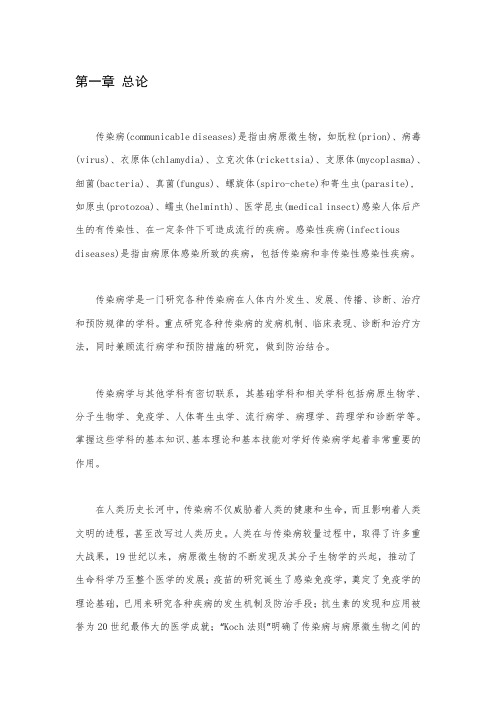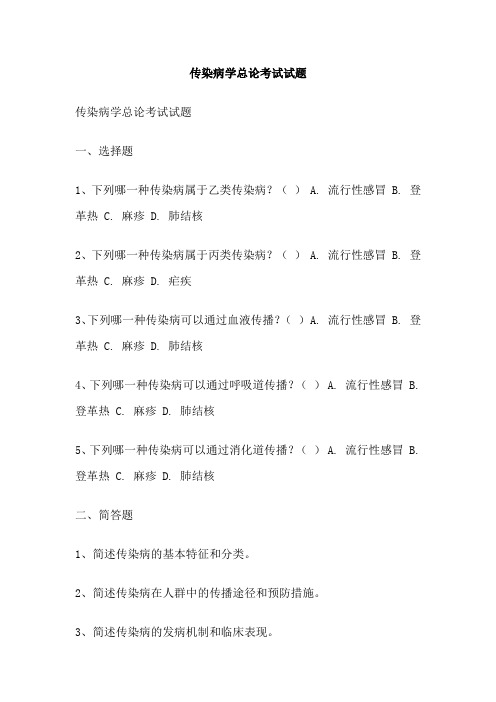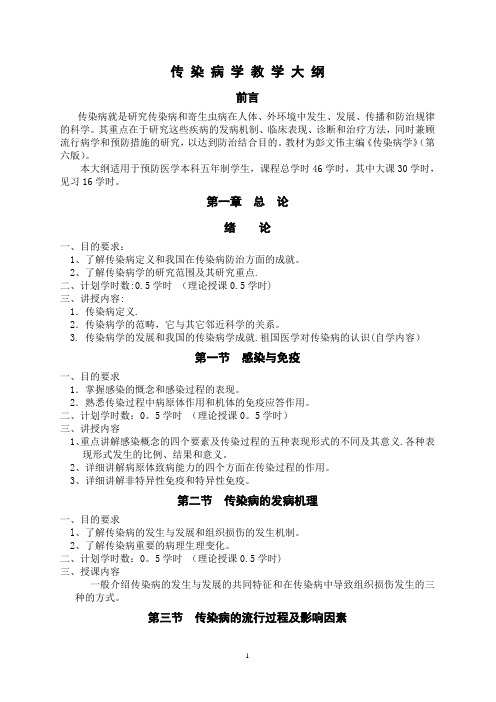传染病学总论——南方医科大学
传染病学总论

一.流行过程的 基本条件
( 一)传染源
(三)人群易感性 (二)传播途径
(一)传染源 是指病原体己在体内生长繁殖并能将
其排出体外的人和动物。传染源包括下 列4个方面。
1.患者 2.隐性感染者 是重要传染源。 3.病原携带者 4.受感染的动物
(二)传播途径
病原体离开传染源后,到达另一个 易感者的途径,称为传播途径。传播 途径由外界环境中各种因素所组成, 从最简单的一个因素到包括许多因素 的复杂传播途径都可发生。
三、重要的病理生理变化
(一)发热
(二)急性期改变
(一)发热
发热常见于传染病,但并非传染病所 特有。外源性致热原(病原体及其产物等)进 入体内,激活单核-吞噬细胞、内皮细胞、 B淋巴细胞等,使后者释放内源性致热原如 IL-1 、 IL-6 、 TNF 、干扰素等。内源性致 热原通过血循环刺激下视丘体温调节中枢 , 使之释放前列腺素E2。后者把恒温点调高, 使产热超过散热而引起体温上升。
病原体感染人体后,寄生在机体中某些 部位,由于机体免疫功能足以将病原体局 限化而不引起显性感染,但又不足以将病 原体清除时,病原体便可长期潜伏下来, 等待机体免疫功能下降时,才引起显性感 染。潜伏性感染期间,病原体一般不排出 体外,这是与病原携带状态不同之点。潜 伏性感染并不是在每个传染病中都存在。
(二)急性期改变
感染、创伤、炎症等过程所引起的一 系列急性期机体应答称为急性期改变。它 出现于感染发生后几小时至几天,也可见 于某些慢性疾病。主要的改变有:
1.蛋白代谢
2.糖代谢
3.水电解质代谢
4.内分泌改变
第三节
传染病的流行 过程及影响因素
传染病的流行过程就是传染病在人 群中发生、发展和转归的过程。 流行过 程的发生需要有三个基本条件,就是传 染源、传播途径和人群易感性。 流行过 程本身又受社会因素和自然因素的影响。
《传染病学》第九版 第一章 总论

第一章总论传染病(communicable diseases)是指由病原微生物,如朊粒(prion)、病毒(virus)、衣原体(chlamydia)、立克次体(rickettsia)、支原体(mycoplasma)、细菌(bacteria)、真菌(fungus)、螺旋体(spiro-chete)和寄生虫(parasite),如原虫(protozoa)、蠕虫(helminth)、医学昆虫(medical insect)感染人体后产生的有传染性、在一定条件下可造成流行的疾病。
感染性疾病(infectious diseases)是指由病原体感染所致的疾病,包括传染病和非传染性感染性疾病。
传染病学是一门研究各种传染病在人体内外发生、发展、传播、诊断、治疗和预防规律的学科。
重点研究各种传染病的发病机制、临床表现、诊断和治疗方法,同时兼顾流行病学和预防措施的研究,做到防治结合。
传染病学与其他学科有密切联系,其基础学科和相关学科包括病原生物学、分子生物学、免疫学、人体寄生虫学、流行病学、病理学、药理学和诊断学等。
掌握这些学科的基本知识、基本理论和基本技能对学好传染病学起着非常重要的作用。
在人类历史长河中,传染病不仅威胁着人类的健康和生命,而且影响着人类文明的进程,甚至改写过人类历史。
人类在与传染病较量过程中,取得了许多重大战果,19世纪以来,病原微生物的不断发现及其分子生物学的兴起,推动了生命科学乃至整个医学的发展;疫苗的研究诞生了感染免疫学,奠定了免疫学的理论基础,已用来研究各种疾病的发生机制及防治手段;抗生素的发现和应用被誉为20世纪最伟大的医学成就;“Koch法则”明确了传染病与病原微生物之间的因果关系,建立了病原学理论,已被广泛应用到其他许多疾病的研究,奠定了现代医学发展的基石。
正是由于上述辉煌战果,加上社会文明的推进和物质生活水平的提高,人类逐渐在与传染病的斗争中占了上风。
20世纪70年代西方医学界一度认为,传染病正在消亡。
传染病学知识点总结

传染病学知识点总结第一单元总论一、感染过程传染过程的三因素:病原体、人体、外环境感染后表现:病原体被清除隐性感染:感染病原体后不出现临床表现,但产生了特异性免疫。
――最常见显性感染――最易识别病原携带状态――重要的传染源潜伏性感染:人体与病原体处于相持状态,不出现临床症状,不排出病原体。
二、病原体的作用发病的两个因素:病原体的致病能力和机体的免疫功能三、感染过程的免疫应答1、非特异性免疫:天然屏障,吞噬作用,体液因子2、特异性免疫:细胞免疫;体液免疫;**反应四、流行过程的三环节:传染源;传播途径;人群易患性五、传染病的特征1、基本特征:病原体;传染性;流行病学特征;感染后免疫2、临床特征分期:潜伏期;前驱期;症状明显期;恢复期;复发与再燃;后遗症潜伏期是确定检疫期的重要依据及诊断的参考。
3、发疹性传染病按皮疹出现先后次序排列:水痘,猩红热,天花,麻疹,斑疹伤寒,伤寒六、传染病的预防传染病分类:甲类2种,乙类25种,丙类10种第二单元病毒性肝炎一、病原学1、甲肝(H**):属小RNA病毒秤嗜肝病毒2、乙肝(HBV):属嗜肝DNA病毒3、丙肝(HCV):单链RNA病毒4、丁肝(HDV):缺陷的单链RNA病毒5、戊肝(HEV):属杯状病毒二、流行性1、甲、戊型传播途径:粪-口传染源:主要是急性期和亚临床感染者。
发病前2周至发病后2-3周内有传染性。
以发病前后各1周的传染性最强。
2、乙、丙、丁型:传播途径:输血;母婴;密切接触;性接触传染源:急、慢性患者及病毒携带者三、发病机制及病理1、发病机制甲肝――表现为肝细胞坏死和肝组织炎症反应。
乙肝――以细胞免疫为主2、病理(1)急性肝炎:肝细胞变性坏死,气球样变。
(2)慢性肝炎:炎症、坏死及纤维化(3)重型病毒性肝炎:急性重型肝炎:肝体积明显缩小,边缘薄质软,包膜皱缩亚急性重型肝炎:肝质稍硬,表面和切面见再生结节。
慢性重型肝炎:大块性或亚大块性新鲜的肝实质坏死。
传染病学总论考试试题

传染病学总论考试试题
传染病学总论考试试题
一、选择题
1、下列哪一种传染病属于乙类传染病?() A. 流行性感冒 B. 登革热 C. 麻疹 D. 肺结核
2、下列哪一种传染病属于丙类传染病?() A. 流行性感冒 B. 登革热 C. 麻疹 D. 疟疾
3、下列哪一种传染病可以通过血液传播?() A. 流行性感冒 B. 登革热 C. 麻疹 D. 肺结核
4、下列哪一种传染病可以通过呼吸道传播?() A. 流行性感冒 B. 登革热 C. 麻疹 D. 肺结核
5、下列哪一种传染病可以通过消化道传播?() A. 流行性感冒 B. 登革热 C. 麻疹 D. 肺结核
二、简答题
1、简述传染病的基本特征和分类。
2、简述传染病在人群中的传播途径和预防措施。
3、简述传染病的发病机制和临床表现。
4、简述传染病的实验室诊断方法和治疗原则。
5、简述传染病学总论在医学领域中的应用和发展趋势。
三、论述题
1、论述传染病在中国的流行现状和防控措施。
2、论述传染病对人类健康和社会的影响,并阐述如何加强国际合作和交流,共同应对传染病威胁。
3、论述传染病在未来的发展趋势和挑战,并阐述如何加强科学研究和技术创新,提高传染病的预防和治疗水平。
4、论述传染病的多重预防和治疗方法,并阐述如何提高公众的健康意识和自我防护能力,降低传染病的传播风险。
传染病学总论

有严格的地区性和季节性。 如血吸虫病多在长江以南地区流行,因为那里气 候温和,雨量充沛,杂草丛生,适宜钉螺的孳生。 乙脑有严格的季节性,多在7、8、9三个月流行。
消化道传染病多在夏秋季流行,而呼吸道传染病
常在冬春流行,与自然因素有关。
(二)、影响流行过程的因素
社会因素:包括居住条件、卫生设施、劳 动条件等,对传染病的流行起决定性作用。
解放前许多传染病发生流行,大批病人死 亡。 解放后许多传染病迅速得到控制,发病率 大幅度下降,体现了社会主义的优越性。
第四节 传染病的特征与 临床特点
一、基本特征
1.有病原体 原体。 每种传染病都有其特异的病
比如痢疾杆菌只能引起菌痢,麻疹病 毒只能引起麻疹。
目前并非所有传染病的病原体都能分 离出来,一旦分离出病原体,就是传染 病确诊的依据。
2.有传染性 所有传染病都具有一定的传染性, 传染性有大有小,比如麻疹发病率95%, 脊髓灰质炎<1%。 传染病病人有传染性的时期称传染期, 每种传染病的传染期都相对固定,可作 为隔离病人的依据之一。
3.有流行病学特征
4、有感染后免疫
感染后获得的免疫力属于主动免疫。
通过抗体转移而获得的免疫(注射或从母 体获得抗体的免疫力) 属于被动免疫。
4、有感染后免疫 感染后免疫的持续时间在不同传染病中 差异很大。 病毒性传染病的感染后免疫持续时间长, 往往保持终生,但有例外(如流感)。 细菌、螺旋体、原虫性传染病的感染后 免疫持续时间短,仅为数月至数年,也 有例外(如伤寒)。 蠕虫病感染后通常不产生保护性免疫, 因而往往产生重复感染。
2、传播途径
病原体离开传染源后,到达另一个易感者的途径。 包括:
传染病学主治医师专业知识考试大纲

(2)临床资料
(3)实验室检查
(4)其他检查
掌握
6.传染病的治疗
(1)治疗原则
(2)治疗方法
掌握
熟悉
7.传染病的预防
(1)管理传染源(传染病的分类及报告制度)
(2)切断传播途径的措施
(3)保护易感人群的措施
了解
二、病毒感染
1.病毒性肝炎*
(1)病原学:肝炎病毒的种类及其抗原抗体系统
(5)出血量与活动性判断
12.便血
(1)病因
掌握
2.类风湿关节炎
(1)临床症状
(2)诊断要点
(3)辅助检查
(4)治疗要点
掌握
八、神经内科
1.脑血管疾病
(1)临床症状
(2)诊断要点
(3)辅助检查
(4)治疗要点
掌握
2.癫痫
(1)临床症状
(2)诊断要点
(3)辅助检查
(4)治疗要点
掌握
3.痴呆
(1)临床症状
(2)诊断要点
(3)辅助检查
(4)治疗要点
掌握
(4)诊断:间日疟的诊断依据
(5)治疗:病原治疗、控制发作的药物、防制复发和传播的药物、预防药物
(6)预防措施
(7)疟疾的诊断依据及抗疟疾治疗
熟悉
了解
熟悉
掌握
掌握
了解
了解
七、蠕虫感染
1.日本血吸虫病
(1)病原学:病原体
(2)流行病学:传染源、传播途径及人群易感性
(3)临床表现:临床分型、急性血吸虫病及晚期血吸虫病的临床表现
3.伤寒
(1)临床症状
(2)诊断要点
(3)辅助检查
(4)治疗要点
传染病学讲义

第一单元传染病学总论【传染病学特点】【大纲要求】总论考什么?感染的概念感染过程的表现感染过程中病原体的作用感染过程中的免疫应答作用感染病的发病机制流行过程的基本条件影响流行过程的因素传染病的基本特征、临床特征传染病的诊断、治疗及预防重点内容传染病感染过程:5种表现及含义传染病流行过程中3个基本条件传染病的基本特征【概念】传染病感染过程的5种表现病原体被清除隐性感染(亚临床感染)不出现或仅出现不明显的临床表现,免疫学检查有特异性免疫反应显性感染(临床感染)病原体被清除病原携带状态排出病原体,有传染性,携带病原体超过3个月者为慢性携带者。
潜伏性感染免疫功能不足以清除病原体,而将其局限,一旦免疫功能下降,才引起显性感染。
不排出病原体,与病原携带不同。
如单纯疱疹(HSV)、带状疱疹(VZV)、疟疾、结核1感染过程的五种表现在不同传染病中各有侧重,一般最常见的是()A.病原体被清除B.隐性感染C.显性感染D.潜伏性感染E病原携带状态【正确答案】B【答案解析】最不常见的表现是显性感染。
【A2型题】王某,女性,患慢乙肝10年,血HBsAg(+), HBeAg(+),抗HBc(+),其12岁女儿体检时抗HBs(+),追问病史无任何临床症状,未注射乙肝疫苗,王某女儿属于()A.垂直感染B.隐性感染C.显性感染D.潜伏性感染E.病原携带状态【正确答案】B【答案解析】抗HBs(+),无任何临床症状,未注射乙肝疫苗,应该隐性感染过。
【A2型题】男性,20岁,无任何不良反应,体检时,发现血清HBsAg阳性,转氨酶等其他肝功能检查均正常()A.重复感染B.隐性感染C.显性感染D.潜伏性感染E.病原携带状态【正确答案】E【答案解析】HBsAg阳性,转氨酶等其他肝功能检查均正常,应为病原携带者。
传染病感染过程中病原体作用病原体侵入人体后能否引起疾病,取决于病原体的致病作用、宿主的免疫功能和外环境三个因素。
传染病感染过程中免疫应答作用感染病的发病机制传染病的发生与发展入侵部位只有入侵部位适合,病原体才能定植、生长、繁殖及引起病变。
《传染病学》学习复习资料

《传染病学》重点复习集
第一章 总 论 一 、 ★ 传染病的基本 概念 ★传染病(communicable diseases):是指由病原微生物,如阮粒、病毒、衣原体、立克次体、
支原体、细菌、真菌、螺旋体和寄生虫,如原虫、蠕虫、医学昆虫感染人体后产生的有传 染性、在一定条件下可造成流行的疾病。 二、★感染过程的 5 种表现 (一)清除病原体:人体清除病原体的方法:1、非特异性免疫防御能力 2、特异性免疫(体液免疫 和细胞免疫)。 (二)隐 性感染:又称亚临床感 染,病 原体侵 入人体 后,仅 诱导机 体产生 特异性 免疫应 答而不 引起 或引 起轻 微的 组织 损伤 ,因 而在 临床 上不 显出 任何 症状 、体 征甚 至生 化改 变, 只能 通过 免疫 学检查发现。是大多数病毒性传染病 的最常 见的表 现。 (三)显 性感染 :又称临床感染 ,是指 病原体 侵入人 体后 ,不但 诱发机 体发生 免疫 应答 ,而且 通过 病原体本身的作用或机体的变态反应 ,导致 组织损 伤引起 病理 改变和 临床表 现。 (四)病 原携带状态 :是指病原体侵入人 体后 ,可以 停留在 入侵部 位或侵 入较远 的脏器 继续生 长、 繁殖而人体不出现任何的疾病状态,但能携带并排除病原体 (排出体外),成为传染病的传染源。 ★ (五 )潜伏 性感染 :免疫功能足 以将 病原 体局 限化 而不 引起 显性感 染, 在机 体免 疫力 低下 时, 引起显性感染。 三 、 ★ 传染病的流行 过程及影响因素 ★(一)流行过程的 3 个基本条件
①活 动 性 肝 硬 化 :有慢性肝炎活动的表现,常有转氨酶升高、白蛋白下降 。 ②静 止 性 肝 硬 化 :无肝脏炎症活动的表现,症状轻或无特异性。 ★根据肝组织病理及临床表现分为两 型: ①代偿性肝硬化:早期肝硬化,属 Child-Pugh A 级。无明显肝功能衰竭表现。可有门脉高 压症,但无腹水、肝性脑病或上消化 道出血 。 ②失代偿性肝硬化:中晚期肝硬化,属 Child-Pugh B、C 级。有明显肝功能异常及失代偿征 象,如血清白蛋白<35g/ L,A/ G<1.0,胆红素>35mol/ L,PTA<60%。有腹水、肝性脑病及上 消化道出血。 四 、 ★ 实验室检查 ( 一 ) 肝功能检查 血 清 酶 测 定 :A LT:反映肝细胞功能的最常用指标。
传染病学知识点总结

传染病学知识点总结传染病学知识点总结:第一章总论1.传染病是指由病原微生物,如朊粒、病毒、衣原体、立克次体、支原体、细菌、真菌、螺旋体和寄生虫,如原虫、蠕虫、医学昆虫感染人体后产生的有传染性、在一定条件下可造成流行的疾病。
2.感染性疾病是指由病原体感染所致的疾病,包括传染病和非传染性感染性疾病。
3.感染是病原体和人体之间相互作用、相互斗争的过程。
4.当某些因素导致宿主的免疫功能受损,或大量应用抗菌药物引起的菌群失调症,或机械损伤使寄生物离开其固有的寄生部位而到达其他寄生部位,平衡不复存在而引起宿主损伤,这种情况称为机会性感染。
5.感染过程的表现:清除病原体、隐性感染、显性感染、病原携带状态、潜伏性感染。
6.感染过程中病原体的作用:侵袭力(侵袭力是指病原体侵入机体并在机体内生长、繁殖的能力)、毒力、数量、变异性。
7.流行过程的基本条件:传染源、传播途径、人群易感者。
8.对某种传染病缺乏特异性免疫力的人称为易感者。
9.传抱病的基本特征:病原体、传染性、流行病学特征、熏染后免疫。
10.传染病的发展阶段:潜伏期(从病原体侵入人体起,至开始出现临床症状为止的时期,称为潜伏期)、前驱期(从起病至症状明显开始为止的时期称为前驱期)、症状明显期、恢复期。
11.再燃是指当传抱病患者的临床症状和体征逐渐减轻,但体温尚未完整规复正常的缓解阶段,由于埋伏于血液或组织中的病原体再度繁育,使体温再次降低,初发病的症状与体征再度出现的景遇。
12.复发是指当患者进入规复期后,已不乱退热一段时间,由于体内残存的病原体再度繁育而使临床表现再度出现的景遇。
第二章病毒性传染病1.病毒性肝炎是由多种肝炎病毒引起的,以肝脏损害为主的一组全身性传染病。
2.病毒性肝炎按病原学分类:甲型、乙型、丙型、丁型、戊型五型肝炎病毒。
3.急性黄疸型肝炎分期:黄疸前期、黄疸期、规复期。
(体力、消化道、黄染)4.HBV DNA是病毒复制和传染性的直接标志。
定量办法对于判断病毒复制程度,传染性大小、抗病毒药物疗效等有重要意义。
传染病学总论

整理ppt
1
总论
第一节 感染与免疫 第二节 传染病的发病机制 第三节 传染病的流行过程及影响因素 第四节 传染病的特征 第五节 传染病的诊断 第六节 传染病的治疗 第七节 传染病的预防
整理ppt
2
前言
传染病是指由病原微生物如阮粒、病毒、衣原体、 立克次体、衣原体、细菌、真菌、螺旋体和寄生 虫感染人体后产生的传染性、在一定条件下科造 成流行的疾病。
感染性疾病是指由病原体感染所致的疾病,包括 传染病和非传染性感染性疾病。
传染病学是一门研究各种传染病在人体内外发生、 发展、传播、诊断、治疗和预防规律的学科。
整理ppt
3
前言
历史上传染病对人类造成很 大的灾难。 • 鼠疫、霍乱、天花、疟疾、 血吸虫病和黑热病广泛流 行 • 新中国成立后,天花得到 消灭,脊髓灰质炎接近消 灭。
整理ppt
10
一、感染的概念
“新发突发传染病”:新的病原体:如HIV 病毒、SARS相关冠状病毒、甲型H1N1流 感病毒引起的疾病。
“再现传染病”:已经被控制的传染病如 结核病由于种种原因在局部地区流行。
难治性耐药菌株感染:光谱抗生素的滥用 诱发细菌耐药基因突变
整理ppt
11
一、感染的概念:多种形式的感染 情况
病毒性肝炎 • 经过一系列的生活史整,理ppt最后在某脏器定居。 26
一、传染病的发生与发展
(三)排出途径
• 单一途径:志贺菌,粪便 • 多种途径:脊髓灰质炎病毒,粪便,飞沫 • 叮咬或输血:疟原虫
整理ppt
27
二、组织损伤的发生机制
(一)直接损伤:
• 借助其机械运动及其分泌的酶直接破坏组织 • 通过细胞病变而使细胞溶解:脊髓灰质炎病毒 • 通过诱发炎症过程而引起组织坏死:鼠疫
传染病学习题及答案

《传染病学》习题、病例参考答案第一章总论第一节概述一、名词解释1. 传染病:是由病原微生物和寄生虫感染人体或动物体后所引起的有传染性的一类疾病,在一定条件下可在人群中传播并导致流行。
2.感染性疾病:是由病原微生物(细菌、病毒、衣原体、立克次体、支原体、螺旋体、真菌等)和寄生虫(原虫、蠕虫、昆虫)感染人体所致的疾病,包括有传染性的传染病和没有传染性的感染性疾病。
二、简答题传染病学与流行病学的区别研究对象研究重点学科性质传染病学个体临床表现、诊断、治疗临床医学流行病学群体流行规律、预防措施预防医学第二节感染与免疫一、名词解释1.隐性感染:又称亚临床感染,是指病原体侵入人体后,仅诱导机体产生特异性的免疫应答,而不引起或引起轻微的组织损伤,临床上多无症状、体征和生化改变,只有经免疫学检查才能发现。
2.显性感染:又称临床感染。
病原体侵入人体后, 不但诱导机体产生免疫应答,而且通过病原体本身的作用或机体的变态反应导致组织损伤,引起严重的病理改变或临床表现。
3.病原携带状态:病原体进入人体后,停留、存在于机体一定的部位生长繁殖,排出体外,引起轻度的病理损害,而人体不出现疾病的临床表现。
4.潜伏性感染:又称潜在性感染。
病原体进入人体后,病原体与人体在相互作用时,保持暂时的平衡状态,不出现临床表现,待人体防御机能降低,原已潜伏在人休内的病原体乘机繁殖,引起发病。
5.感染(传染):又称传染,是指病原体以一定的方式或途径侵入人体后在人体内的一种寄生过程,也是病原体与人体之间相互作用、相互斗争的过程。
6.非特异性免疫:人类在长期进化过程中形成的,出生时即有的较为稳定的免疫能力。
7. 特异性免疫:人类在后天生活过程中,受到病原刺激,产生针对特异病原的免疫力。
8. 侵袭力:是指病原体侵入机体并在体内扩散的能力。
二、填空题1.病原体人体环境2.病原体被消灭或排出体外病原携带状态隐性感染显性感染潜伏性感染3.侵袭力毒力数量变异性4.天然屏障吞噬作用体液因子5. 细胞免疫体液免疫6.外毒素内毒素三、选择题1.A 2.C 3.D 4.B 5.A 6.E 7.C 8.B 9.C 10.D 11.ABCDE 12.BD 13.ABC四、是非题1.×2.√3.×4.√5.√6.√7.√五、简答题1.感染过程有病原体被消灭或排出体外、病原携带状态、隐性感染、显性感染、潜伏性感染五种表现。
《传染病学》教学大纲

传染病学教学大纲前言传染病就是研究传染病和寄生虫病在人体、外环境中发生、发展、传播和防治规律的科学。
其重点在于研究这些疾病的发病机制、临床表现、诊断和治疗方法,同时兼顾流行病学和预防措施的研究,以达到防治结合目的。
教材为彭文伟主编《传染病学》(第六版)。
本大纲适用于预防医学本科五年制学生,课程总学时46学时,其中大课30学时,见习16学时。
第一章总论绪论一、目的要求:1、了解传染病定义和我国在传染病防治方面的成就。
2、了解传染病学的研究范围及其研究重点.二、计划学时数:0.5学时(理论授课0.5学时)三、讲授内容:1.传染病定义.2.传染病学的范畴,它与其它邻近科学的关系。
3. 传染病学的发展和我国的传染病学成就.祖国医学对传染病的认识(自学内容)第一节感染与免疫一、目的要求1.掌握感染的慨念和感染过程的表现。
2.熟悉传染过程中病原体作用和机体的免疫应答作用。
二、计划学时数:0。
5学时(理论授课0。
5学时)三、讲授内容1、重点讲解感染概念的四个要素及传染过程的五种表现形式的不同及其意义.各种表现形式发生的比例、结果和意义。
2、详细讲解病原体致病能力的四个方面在传染过程的作用。
3、详细讲解非特异性免疫和特异性免疫。
第二节传染病的发病机理一、目的要求l、了解传染病的发生与发展和组织损伤的发生机制。
2、了解传染病重要的病理生理变化。
二、计划学时数:0。
5学时(理论授课0.5学时)三、授课内容一般介绍传染病的发生与发展的共同特征和在传染病中导致组织损伤发生的三种的方式。
第三节传染病的流行过程及影响因素一、目的要求1、掌握流行过程的基本条件2、熟悉影响流行过程的因素二、计划学时数:0。
5学时 (理论授课0.5学时)三、授课内容1、重点讲解流行过程的三个基本条件、特别是传播途径2、一般介绍自然因素和社会因素在传染病流行过程中的影响。
第四节传染病的特征一、目的要求1、掌握传染病的基本特征2、熟悉传染病的临床特点二、计划学时数:0.5学时 (理论授课0。
- 1、下载文档前请自行甄别文档内容的完整性,平台不提供额外的编辑、内容补充、找答案等附加服务。
- 2、"仅部分预览"的文档,不可在线预览部分如存在完整性等问题,可反馈申请退款(可完整预览的文档不适用该条件!)。
- 3、如文档侵犯您的权益,请联系客服反馈,我们会尽快为您处理(人工客服工作时间:9:00-18:30)。
12
1. 清除病原体
非特异性防御能力 non-specific immunity 特异性免疫功能 specific immunity
15
4.病原携带状态
病原体侵入人体后,人体不出现任何的疾病状 态,但能携带并排出病原体,成为传染病流行 的传染源 No clinical manifestation but microorganism excreted
分类:
— 按病原体: virus carrier, bacteria carrier — 按发生和持续时间:convalescent, healthy or incubatory carrier — 按携带病原体的持续时间: acute or chronic carrier
与宿主之间的平衡被打破而引起宿主的损伤。
10
临床感染形式
首发感染 (Primary infection) 重复感染 (re-infection) 混合感染 (co-infection) 重叠感染 (super infection) 继发感染 (secondary infection)
11
二、感染过程的表现(感染谱)
16
5. 潜伏性感染
病原体感染人体后,机体免疫功能足以将病原 体局限化但又不足以将病原体清除,病原体长 期潜伏起来,待机体免疫功能下降时引起显性 感染 Locates the pathogen but can not wipes it out, can latently
for a long time, can occurs overt infection
relation with the pathogenicity in the same infectious disease
不同的传染病,能引起疾病的最低病原体 数量可有较大差异 The least number of the pathogen to
induce disease differ greatly in different diseases. For example, S. typhi is 10000 and Sh. dysenteriae is only 10
22
4.变异性
变异因素 variation factors
— 环境 environmental、药物 drug、遗传 hereditary
变异类型 various forms
— 致病力变异 pathogenicity variation — 抗原性变异 antigenic variation — 耐药性变异 drug-resistant variation
32
一、流行过程的基本条件
传染源 source of infection
— 患者 measles — 隐性感染者 poliomyelitis — 病原携带者 typhoid fever, bacillary dysentery — 受感染的动物 rabies, plague, leptospirosis, typhus
病原体通常被清除,但少数人可转变为病原携 带状态 Pathogens can be eradicated or carried
14
3.显性感染
病原体侵入人体后,不但诱发免疫应答,而且 通过病原体本身或机体的变态反应,导致组织 损 伤 , 引 起 病 理 改 变 和 临 床 表 现 Make the host
producing specific immune response, having pathological changes
显性感染过程结束后,有些传染病可使感染者 获得较为稳固的免疫力,另一些传染病免疫力 并不牢固 Immunity can be consolidated or temporary
通过细菌表面成分(如伤寒沙门菌Vi抗原)抑 制吞噬而促进病原体扩散 promote spread:Vi antigen of
Salmonella typhi
20
2.毒力
毒素 toxins
— 外毒素 exotoxin (Vibrio cholera, Clostridium tetani,
Corynebacterium diphtheriae)
23
四、感染过程中的免疫应答
保护性免疫应答:有利于机体抵抗病原体
非特异性免疫 — 天然屏障 natural barriers — 吞噬作用 phagocytosis — 体液因子 humoral factors
特异性免疫 — 细胞免疫 cell-mediated immunity — 体液免疫 humoral immunity
《流感下的北京中年》 《流感下的广州夫妇》
Worldwide mortality due to infectious diseases
第一节 感染与免疫
9
一、感染的概念
• 感染(infection) 病原体和人体之间相互作用的过程。
• 机会性感染(opportunistic infection) 由于某些因素的影响,造成原来寄生的微生物或寄生虫
33
一、流行过程的基本条件
传播途径 route of transmission
— 呼吸道传播 — 消化道传播 — 接触传播 contagious transmission — 虫媒传播 arthropod-bone transmission
(blood-sucking arthropods: mosquito, lice, flea, sandfly, mite, tick)
35
二、影响流行过程的因素
自然因素 natural factors
— geography, climate, ecology — 疫源地 focus of infection —自然疫源性传染病/人兽共患病 zoonosis
(plague, leptospirosis, human avian influenza)
变态反应:促进病理改变
— 特异性
24
25
The innate immune response to viral infection
26
Host immune response against acute virus infection
27
第二节 传染病的发病机制
28
一、传染病的发生与发展
入侵部位 position of invasion 机体内定位 location in the body 排出途径 route of exclusion
— 主动免疫 active immunity — 被动免疫 passive immunity
13
2.隐性感染
病原体仅诱导机体产生特异性免疫应答,不引 起或只引起轻微的组织损伤,在临床上不显出 任何症状、体征,甚至生化改变,只能通过免 疫学检查才能发现 Only make the host producing specific
29
二、组织损伤的发生机制
直接损伤 direct damage 毒素作用 action of the toxin 免疫机制 immunity mechanism
30
三、重要的病理生理变化
发热 pyrexia 急性期改变
— 蛋白代谢 — 糖代谢 — 水电解质代谢 — 内分泌改变
31
第三节 传染病的流行过程
— 内毒素 endotoxin (S. typhi, Sh. dysentery)
其他毒力因子
— 穿透能力 filariform larva of Ancylostoma — 侵袭能力 Sh. dysenteriae — 溶组织能力 Entamoeba histolytica
21
3.数量
同一种传染病,入侵病原体的数量与致病 能力成正比 The number of invading pathogen is positive
传染病都属于感染性疾病,但感染性疾病不一定都有传染性。3
传染病—历史与现状
• 已消灭:天花; 麻风?脊灰炎? • 已控制:鼠疫、霍乱、血吸虫病 • 正流行:乙肝,出血热,腹泻…… • 新发感染病(EID):艾滋病、SARS、人感染高致病性 禽流感(H7N9),MERS-CoV……
4
Zika virus emergence in the Americas
潜伏性感染与病原携带状态的区别?What is the
different point between latent infection and carrier state ?
17
感染谱频度
潜伏感染 显性感染 病原携带状态 隐性感染 清除病原体
18
三、感染过程中病原体的作用
侵袭力 invasiveness 毒力 virulence 数量 quantity of pathogens 变异性 variability
19
1.侵袭力
直接侵入人体 invade directly
Leptospira, filariform larva of Ancylostoma
先黏附于肠或支气管黏膜表面,再侵入组织细 胞,如志贺菌、结核分枝杆菌。致泻性大肠埃 希菌能表达受体(定植因子)和小肠细胞结合
adhere, colonize and produce enterotoxin: Vibrio cholera
38
1.病原体
有特异性 specific 应用新技术可发现更多病原体
Be found with natural science advancements
